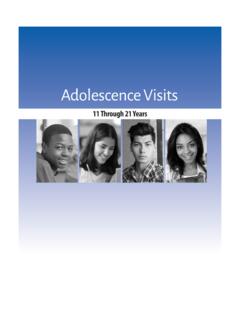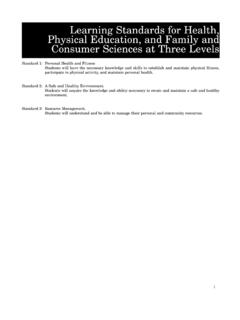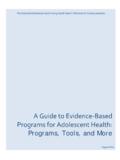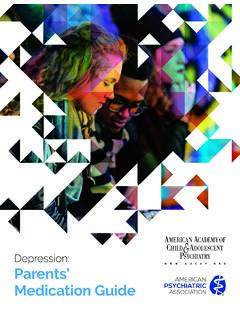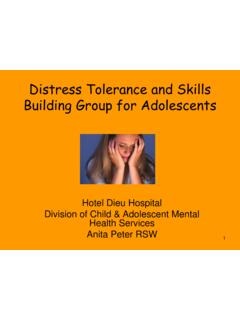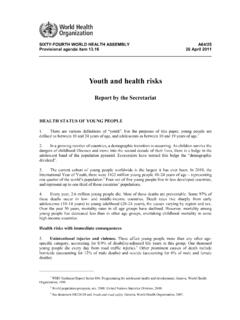Transcription of Validation of the Adolescent Self-Esteem Questionnaire
1 Validation OF THE Adolescent Self-Esteem Questionnaire Technical report 2 Validation of the Adolescent Self-Esteem Questionnaire Suggested citation: Hafekost K., Boterhoven de Haan K., Lawrence, D., Sawyer , and Zubrick , (2017) Validation of the Adolescent Self-Esteem Questionnaire : Technical Report: Telethon Kids Institute and the Graduate School of Education, The University of Western Australia, Perth, Australia. Acknowledgments: Young Minds Matter: The Second Child and Adolescent Survey of Mental health and Wellbeing was funded by the Australian Government Department of Health. The authors would like to acknowledge the contribution of the families involved in YMM, and schools, students and teachers who contributed their time to this study.
2 Validation of the Adolescent Self-Esteem Questionnaire 3 3 Contents Validation of the Adolescent .. 1 Self-Esteem Questionnaire .. 1 Technical report .. 1 Project Summary .. 5 About Young Minds Matter .. 6 Background .. 7 Project Aims .. 9 Methods .. 10 Study 1 .. 10 Participants .. 10 Procedure .. 10 Diagnostic Interview Schedule for Children (Youth Informant) Version IV (DISC-IV) .. 11 Statistical Analysis .. 11 Study 2 .. 12 Participants .. 12 Procedure .. 13 The Adolescent Self-Esteem Questionnaire (ASQ) .. 13 The Rosenberg Self-Esteem Scale (RSES; 1965) .. 13 The Beck Depression Inventory Youth (BDI-Y) .. 13 Statistical analysis .. 14 Results ..15 Study 1 ..15 Demographic characteristics ..15 Factor analysis ..15 Scale characteristics.
3 18 Study 2 .. 23 Demographic characteristics .. 23 Scale characteristics .. 23 Missing data .. 23 Internal consistency and reliability .. 24 Construct validity .. 24 Findings .. 25 Limitations .. 26 Conclusion .. 27 4 Validation of the Adolescent Self-Esteem Questionnaire Data Access .. 28 References .. 29 Supplementary material .. Error! Bookmark not defined. Validation of the Adolescent Self-Esteem Questionnaire 5 5 SUMMARY This document describes the Validation of the Adolescent Self-Esteem Questionnaire (ASQ) which was developed for the purpose of measuring Self-Esteem in Young Minds Matter: the second Australian child and Adolescent survey of mental health and wellbeing (YMM). The existing gold standard measure of global Self-Esteem , the Rosenberg Self-Esteem Scale (RSES) was identified to be somewhat outdated, in language and concepts, for use in a contemporary Australian youth population.
4 Therefore, we sought to develop a short scale which captured global Self-Esteem which could be included in the youth self -report component of YMM. In order to validate the scale we used data from two study populations. The first was the nationally representative sample of 2,964 11 to 17 year-olds who participated in YMM. These data were used to undertake a factor analysis of the items, and also to establish population norms for the scale. The second study included 304 Western Australian school students aged between 14 and 17 years, which was used to compare the ASQ with the RSES and to assess the test-retest stability of the ASQ. The properties of the scale were examined, and its reliability and validity were compared to the existing gold standard measure of Self-Esteem , the Rosenberg Self-Esteem Scale (RSES).
5 Factor analysis allowed for investigation of the underlying concepts captured by the ASQ, and population norms and a clinically meaningful threshold which was used to define low levels of Self-Esteem , were calculated. The ASQ performed as well as the RSES. In addition, the ASQ was highly predictive of depression, suggesting good construct validity. The inclusion of the ASQ in YMM provided us with nationally representative data from which sex-specific population norms, and a clinically meaningful definition of Self-Esteem , could be derived. Population norms are provided in this report, and a threshold for low Self-Esteem has been identified to assist researchers using the ASQ measure with the YMM Confidentialised Unit Record File (CURF).
6 This information may also allow the ASQ to be useful as a tool in future research and practice. 6 Validation of the Adolescent Self-Esteem Questionnaire About Young Minds Matter Mental health problems are among the most common and burdensome health conditions in children and young people. Without appropriate treatment, they can be persistent and disabling, and can adversely affect children s learning and development. Young Minds Matter, the second Australian Child and Adolescent Survey of Mental Health and Wellbeing was conducted as part of the Australian Government Department of Health s National Survey of Mental Health and Wellbeing programme. The survey was conducted to provide information to support improving mental health services for children and adolescents experiencing mental health problems and their families.
7 Over 6,300 families with children and adolescents aged 4-17 years from around Australia participated in the survey. Information was collected from primary carers via a face-to-face diagnostic interview, and directly from adolescents aged 11-17 years via a self -complete Questionnaire administered using tablet computers. The main aims of the survey were to determine how many children and adolescents had which mental health problems and disorders the nature and impact of these problems and disorders how many children and adolescents had used services for mental health problems; and the role of the education sector in providing these services. Further information about YMM is available at Validation of the Adolescent Self-Esteem Questionnaire 7 7 BACKGROUND Young Minds Matter sought to collect information about mental health and wellbeing of Australian children and young people including identifying the prevalence of mental health problems and disorders, the environments in which children live and the relationship of mental health and wellbeing to family and school characteristics, the impact of mental disorders, risk factors associated with mental health and wellbeing, and use of services and unmet need for services.
8 Self-Esteem has been identified as being associated with mental health and wellbeing, and has been associated with health risk behaviours that are also associated with poor mental health. Recognising that Self-Esteem is an important component of Adolescent wellbeing, a measure of Self-Esteem was sought for inclusion in YMM. As there were a substantial number of content areas to be covered in the YMM Questionnaire , and practical constraints on the length of the Questionnaire , a brief measure of global Self-Esteem was desirable. While there is no single agreed definition and theory of Self-Esteem , it is generally considered to represent an individual s overall appraisal of themselves and their value as a person 1. It is considered to be the evaluative and affective components of the sense of self 2, 3.
9 Self-Esteem is thought to be an assessment of competency and worth as a person in relation to others 4. Self-Esteem reflects the components of self -concept that are considered to be important by the individual. It spans across domains and roles, and consists of both positive and negative self -judgements 5. A number of different constructs of Self-Esteem have been discussed in the literature. For example, global or trait Self-Esteem refers to an individual s assessment of themselves overall, or general feelings about themselves relative to others. In contrast, domain-specific Self-Esteem refers to evaluations in a particular area. For example, an individual could have low academic Self-Esteem and high Self-Esteem regarding their athletic ability.
10 State Self-Esteem is typically used to capture Self-Esteem in a specific moment or setting 6. While Self-Esteem is a topic of much research, the difficulties in measuring Self-Esteem , and using Self-Esteem scores to accurately predict life outcomes and behaviours, have been documented 6. Self-Esteem is not static but rather it fluctuates in response to situational factors, and over the life course. Robins and Trzeniewski note that Self-Esteem is typically high in childhood and adulthood but is lower in adolescence and old age 7. The authors attributed the decline in Self-Esteem in adolescence to improvements in abstract thinking, greater comprehension of abilities relative to 8 Validation of the Adolescent Self-Esteem Questionnaire others, growing awareness of body image, and academic and social challenges associated with school transitions.

